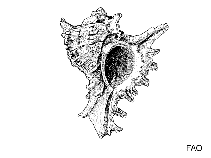Rapana venosa (Valenciennes, 1846)
Purple whelk| Native range | All suitable habitat | Point map | Year 2050 |

|
| This map was computer-generated and has not yet been reviewed. |
| Rapana venosa AquaMaps Data sources: GBIF OBIS |
تصوير گوگل | No image available for this species;
drawing shows typical species in Muricidae.
رده بندی / Names اسامي عام | مترادف | CoL | ITIS | WoRMS
Gastropoda | Neogastropoda | Muricidae
Environment: milieu / climate zone / تغييرات عمق / distribution range بوم شناسي
; لب شور; تغييرات عمق 10 - 60 m (مرجع 83435). Tropical; 4°C - 35°C (مرجع 88058); 41°N - 16°N, 53°E - 143°E
Distribution كشورها | مناطق سازمان خوار و بار جهاني (FAO) | Ecosystems | ظهور | معرفي
Indo-West Pacific. Introduced in the Atlantic, the Mediterranean and Black Sea.
Length at first maturity / Size / Weight / سن
بلوغ: Lm ? range ? - ? cm Max length : 16.1 cm SHH جنس نر / بدون خواص جنسي; (مرجع 83435)
توصيف مختصر ريخت شناسي
Life cycle and mating behavior بلوغ | تولید مثل | تخم ریزی | Eggs | Fecundity | Larvae
مآخذ اصلی
مراجع | هماهنگ كننده | همكاران
Tan, K.S. 2000 Species checklist of Muricidae (Mollusca: Gastropoda) in the South China Sea. The Raffles Bulletin of Zoology 8:495-512. (مرجع 81755)
وضعيت در فهرست قرمز IUCN
(مرجع 130435: Version 2025-1)
وضعيت از نظر سايتس (مرجع 108899)
CMS (مرجع 116361)
خطر برای انسان ها
استفاده انسانی
ماهي گيري – شيلات: تجاري
| FishSource | Sea Around Us
ابزارها
اطلاعات بيشتر
منابع اينترنتي
BHL | BOLD Systems | CISTI | DiscoverLife | FAO(Publication : search) | Fishipedia | GenBank (ژنوم, نوکلئوتيد) | GloBI | Gomexsi | Google Books | Google Scholar | Google | PubMed | Tree of Life | Wikipedia (برو, جستجو) | Zoological Record



